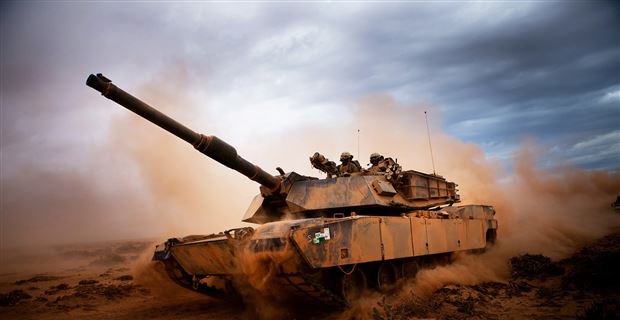The world has managed to make it through most of 2017 without the return of cataclysmic, great power conflict. In some parts of the world (most
 |
| M1A1 Abrams Main Battle Tank during training(Photo: Flickr/U.S. Marine Corps/Public domain, 247Sports) |
The world has managed to make itthrough most of 2017[3]without the return of cataclysmic, great power conflict. In some parts of the world (most notably Syria) tensions have declined significantly. In others, already difficult situations have grown even more tense. Here are five crises that could lead to great power conflict over the course of 2018.
North Korea
North Korea is undoubtedly the most serious foreign-policy crisis facing the world today. The DPRK’s success in developing ballistic missiles, combined with the diplomatic inexperience of the Trump administration, have created an extraordinarily dangerous situation. Having repeatedly conducted missile and nuclear tests over the last decade, North Korea is showing no inclination to collapse under U.S. pressure. The United States hasresponded[4]with diplomatic incoherence, as senior officials often contradict each other within hours of making statements.
To complicate the issue, North Korea and the United States both have substantial incentives to pre-empt; the United States in order to destroy North Korean communications and installation before the missiles can leave the ground, and the North Koreans in order to avoid such a fate. This situation could easily lead to miscalculation by either side, andthe potential for war that could draw in[5]Japan and China.
Taiwan
Recentaggressive statements[9]by Chinese military and diplomatic leaders suggest that at least some in the PRC believe that the military balance has shifted in their favor. This perception is almost certainly premature, and is likely not shared by the balance of China’s leadership, but nonetheless remains quite dangerous. China has also stepped up military activity in the region, although given the PRC’s steadily increasing military profile, this could be said of nearly every region along its borders.
The United States has responded with equanimity, condemning Chinese moves and announcing amajor set of arms sales to Taiwan[10]. However, the Trump administration had muddied the diplomatic waters through its confused stance on North Korea, which has included a major appeal to China for tighter sanctions. For a relationship that demands predictability and careful diplomacy, important players in China and the United States seem eager to embrace uncertainty, which could lead to devastating conflict.
Ukraine
The situation in Ukraine remains tense. The tenuous cease-fire in Eastern Ukraine is increasinglypunctuated by violence[11]between Kiev and Moscow-supported local militias. In Kiev itself, protests, demonstrations and the bizarre saga of former Georgianpresident Mikheil Saakashvili have raised[12]questions about the stability of the government.
Conflict could break out in several ways. A Ukrainian government collapse, while theoretically beneficial to Moscow, could introduce violent instability. Moscow’s proxies might feel emboldened, and Putin himself might see a chance to seize more of the country. Conversely, a collapse of the Kiev government could bring right-wing hardliners to power, which would throw gasoline on the smoldering conflict in the eastern provinces.
Although theTrump administration has backed away[13]from even the tepid support offered to Kiev by President Obama, a serious Russian military incursion into Ukraine, precipitated either by a collapse or an offensive, could threaten to draw Europe and the United States into conflict against Moscow.
NATO’s Southern Flank
Relations between the United States and Turkey have virtually collapsed over the last year, just as Ankara and Moscow have seen a significant rapprochement aftermilitary skirmishes in 2015[14]. Turkish estrangement from the EU and the United States, symbolized by the acquisition of new Russian military hardware, could herald a significant shift in the regional balance of power.
To be sure, Turkey, Russia, nor the United States see war as a reasonable way of resolving the new diplomatic situation. But Turkey is an immensely important country, and its disposition affects the outcome of conflicts in Syria, Iraq, Iran, the Balkans and the Caucasus. A shift in Turkey’s diplomatic orientation could have unpredictable ripple effects along its borders—especially regarding Kurdish aspiration for statehood—and could change the ledger of power and risk in the Nagorno-Karabakh dispute. Such developments could affect how the southern European states think about their commitment to NATO. This unpredictability could cause either Moscow or Washington to miscalculate the strength of their own hands.
The Gulf
Conflicts in the Middle East almost always contain the seeds of great power conflict, even if those seeds rarely bloom. As the civil war in Syria has shambled towards it conclusion, attention has shifted to the confrontation between Iran and Saudi Arabia. Saudi Arabia still seems to have an itchy trigger finger, and it seems eager to find Tehran’s hand behind every setback. For its part, Iran continues expanding its influence in Iraq, Syria and elsewhere.
For its part, while the Trump administration has largely accepted the victory of Assad’s regime in Syria, it isredirecting its efforts towards[15]countering Iran in the region. This has included a virtual blank check to Saudi Arabia in Yemen and elsewhere, a development that could easily result in overconfidence in Riyadh.
Could Riyadh and Tehran contain their war? War has broken out in the Gulf before without engulfing the rest of the world, but Riyadh has demonstrated a clear willingness to build a diplomatic and military coalition against Iran, perhaps going so far as to include Israel. With Russia reasserting its position in the region, it’s depressingly easy to imagine great power conflict.
Conclusion
The world remains jarringly dangerous. The diplomatic confusion of the Trump administration has only added to this danger, creating uncertainty around the world as to U.S. intentions and capabilities. While this uncertainty does not always result in opportunities for other states to step up, it does increase the chance for miscalculation in crisis and noncrisis situations. Hopefully, as Trump’s foreign policy team congeals and matures, it will develop a more coherent approach to diplomacy that will ameliorate the threat posed by some of these crises.
This story was originally published by The National Interest